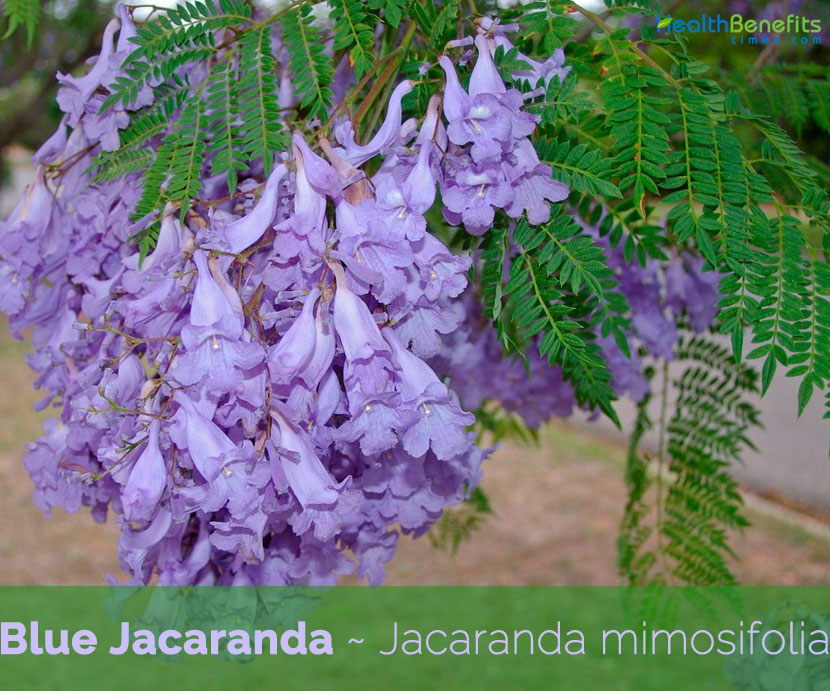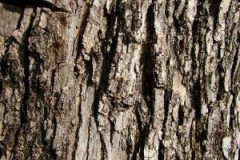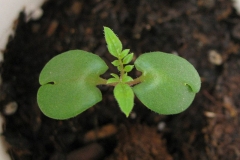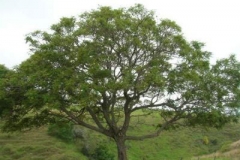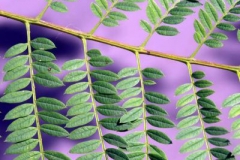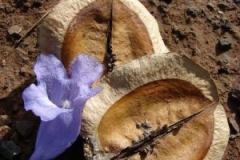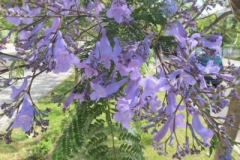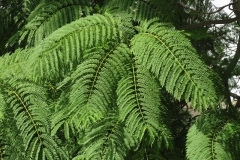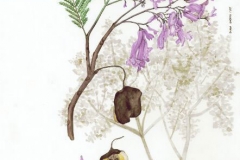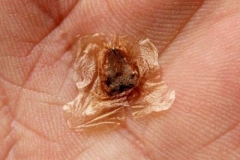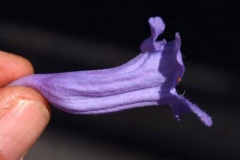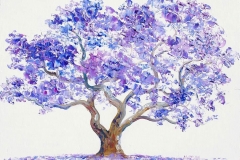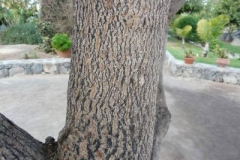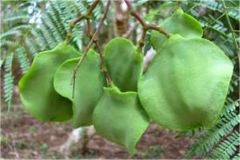Plant Description
Blue Jacaranda is a fast growing, striking ornamental, deciduous or semi-evergreen tree that grows about 5-15 m tall and up to 20-25 m on favorable sites. Bole is almost always short and malformed; it can be up to 40 – 50cm in diameter. The plant is found growing in bush land, grassland, wooded ravines, riverbanks, drier or mesic areas, in savanna and other grasslands, riparian woodland and other riverside habitats, also in forests and in sheltered situations such as in wooded ravines. Bark is thin and grey-brown in color, smooth when the tree is young though it eventually becomes finely scaly rough, with shallow grooves. Twigs are slender and slightly zigzag; they are a light reddish-brown in color.
Plant
| Blue Jacaranda Quick Facts | |
|---|---|
| Name: | Blue Jacaranda |
| Scientific Name: | Jacaranda mimosifolia |
| Origin | Central and eastern South America, including Uruguay, parts of Argentina (Entre Rios, Jujuy, Salta, Tucuman), Paraguay (Alto Paraguay, Cordillera) and as far as Bolivia |
| Colors | Green when young turning to reddish brown as they matures |
| Shapes | Hard, round, flat, reddish brown, woody capsule, 3.2-5.8 cm (1.2-2.28 in) in length and 4-6 cm (1.5-2.3 in) in width |
| Health benefits | Beneficial for amoebic dysentery, syphilis, hepatitis, neuralgia and varicose veins, skin infections, bacterial infections and gonorrhea |
| Height | 20-40 feet |
| Spread | 45-60 feet |
| Crown Uniformity | Irregular |
| Crown Shape | Vase, spreading |
| Crown density | Open |
| Growth Rate | Fast |
| Texture | Fine |
Trunk and Branches
| Trunk/branches | branches droop; showy; typically one trunk; no thorns |
| Bark | light brown, smooth, becoming blocky and rough with age |
| Pruning requirement | needed for strong structure |
| Breakage | susceptible to breakage |
| Current year twig color | gray, brown |
| Current year twig thickness | thick |
| Wood specific gravity | unknown |
Leaves
Blue Jacaranda leaves are arranged alternately, their length is between 25 and 45 cm (10-18 in) and they are bipinnately compound. Each compound leave consists of 13 to 31 elliptic to elliptic-oblong pinnae, and each pinnae of 10 to 41 stable leaflets. The shape of the leaflets is elongated to elongated-ellipsoid, their color is green, and they have a length of 3-12 mm (0.12-0.48 in) and a width of 1-4 mm (0.04-0.16 in).
| Leaf Arrangement | Alternate |
| Leaf type | Bipinnately compound, odd-pinnately compound, made up of 20 secondary leaflets per primary leaflet |
| Leaf Margin | Entire |
| Leaf Shape | Obovate, rhomboid |
| Leaf venation | unknown |
| Leaf type and persistence | deciduous |
| Leaf blade length | 9 to 18 inches, primary leaflets are 5 inches, secondary leaflets are ¼ inch |
| Leaf Color | Green |
| Fall Color | No color change |
| Fall characteristics | Not showy |
Flower
The tubular-shaped flowers are hermaphrodite. Their amazing color varies with the shade of blue – blue-purple, lilac-purple, lavender blue or mauve. Flowers are carried on clusters – upright terminal panicle inflorescences the length of which reaches up to 45 cm (18 in). The size of each individual flower varies in length from 2.4 to 5.2 cm (1-2 in) and in width between 0.7 to 1.2 cm (0.27-0.47 in). Flowering normally takes place from May to August.
| Flower Color | lavender to violet purple |
| Flower Characteristics | very showy; lightly fragrant; emerges on numerous 12-18 inches long panicles |
| Flowering | spring and summer |
Fertile flowers are followed by hard, round, flat, reddish brown, woody capsule, 3.2-5.8 cm (1.2-2.28 in) in length and 4-6 cm (1.5-2.3 in) in width containing numerous small winged seeds. Seeds are small flat, winged that are 5-6 mm (0.19-0.23 in) long and 4-4.5 mm (0.15-0.17 in) wide. To harvest the seeds for replanting, pick the seed pods directly from the tree when they are dry. Pods that have fallen to the ground may not contain seeds.
| Fruit shape | round, disk-like capsule |
| Fruit length | 3 inches |
| Fruit Covering | Dry or hard |
| Fruit color | brown |
| Fruit Characteristics | does not attract wildlife; not showy; fruit/leaves a litter problem |
Traditional uses and benefits of Blue Jacaranda
- The bark and roots of this species are used to treat syphilis.
- Infusions of the flowers are used to treat amoebic dysentery in Guatemala and Mexico.
- Flowers, leaves and bark are administered for the treatment of Neuralgia and Varicose Veins and generally against infections.
- The tree is used to treat hepatitis.
- In folk tradition the flowers, leaves and bark are used to ease neuralgia and varicose veins.
- Hot Jacaranda leaf baths treat wounds and skin infections.
- Tree also helps in the treatment of acne.
- Teaspoon of juice obtained from the leaves of Jacaranda mimosifolia cures health problems associated with venereal diseases.
- Leaf extract or juice can also be applied externally for relief from sores or ulcers caused by venereal diseases.
- Infusion can be used internally for relief from syphilitic sores.
- Volatile oil obtained from Jacaranda leaves and bark has been found to be effective in the treatment of buboes.
- It has been used as a natural remedy for treating bacterial infections, gonorrhea, syphilis and leukemia.
- It is also used to treat neuralgia, varicose veins, acne, treat wounds and skin infections.
Other facts
- Timber of J. mimosifolia is used for interior carpentry and poles and to make small items such as tool handles and carvings.
- It is also used for fuel.
- J. mimosifolia provides pleasant open shade and is an effective windbreak, but is most widely planted as an ornamental.
- Bark extracts are also used to suppress the hatching of larval soil nematodes.
- J. mimosifolia is used as bee forage and is an excellent source of nectar for African honey bees in Ethiopia.
References:
http://www.theplantlist.org/tpl/record/kew-317311
https://www.itis.gov/servlet/SingleRpt/SingleRpt?search_topic=TSN&search_value=34320#null
https://davesgarden.com/guides/pf/go/248152/
http://www.hear.org/pier/species/jacaranda_mimosifolia.htm
https://npgsweb.ars-grin.gov/gringlobal/taxonomydetail.aspx?id=20600
https://www.cabi.org/ISC/datasheet/29212
http://www.missouribotanicalgarden.org/PlantFinder/PlantFinderDetails.aspx?kempercode=a873
http://www.floracatalana.net/jacaranda-mimosifolia-d-don-
http://luirig.altervista.org/schedenam/fnam.php?taxon=Jacaranda+mimosifolia
https://plants.usda.gov/core/profile?symbol=JAMI
https://edis.ifas.ufl.edu/st317
http://www.public.asu.edu/~camartin/plants/Plant%20html%20files/jacarandamimosifolia.html
https://en.wikipedia.org/wiki/Jacaranda_mimosifolia
https://indiabiodiversity.org/species/show/265966
https://gd.eppo.int/taxon/IACMI
http://www.worldagroforestry.org/treedb/AFTPDFS/Jacaranda_mimosifolia.PDF
https://apps.cals.arizona.edu/arboretum/taxon.aspx?id=141
https://wiki.kidzsearch.com/wiki/Jacaranda


